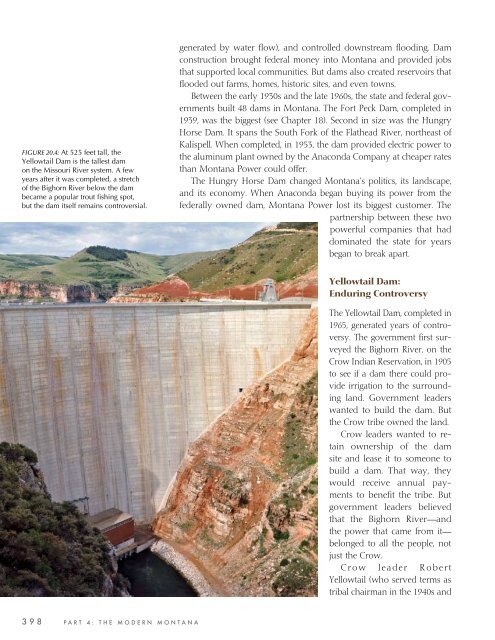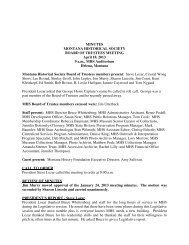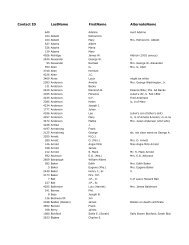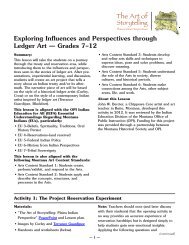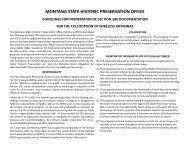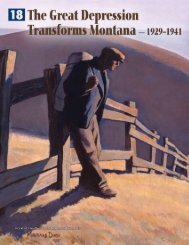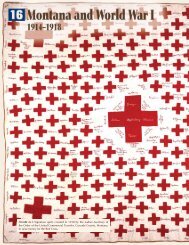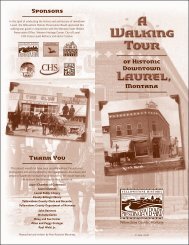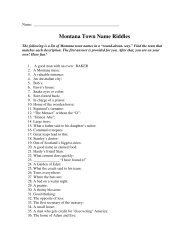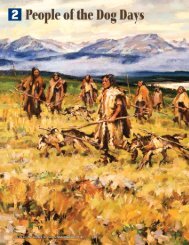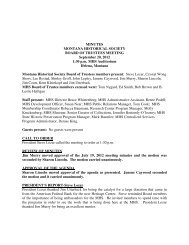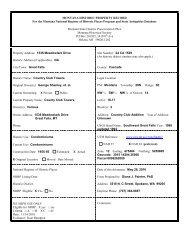Chapter 20 - Montana Historical Society
Chapter 20 - Montana Historical Society
Chapter 20 - Montana Historical Society
Create successful ePaper yourself
Turn your PDF publications into a flip-book with our unique Google optimized e-Paper software.
FIGURE <strong>20</strong>.4: At 525 feet tall, the<br />
Yellowtail Dam is the tallest dam<br />
on the Missouri River system. A few<br />
years after it was completed, a stretch<br />
of the Bighorn River below the dam<br />
became a popular trout fi shing spot,<br />
but the dam itself remains controversial.<br />
3 9 8 P A R T 4 : T H E M O D E R N M O N T A N A<br />
generated by water fl ow), and controlled downstream fl ooding. Dam<br />
construction brought federal money into <strong>Montana</strong> and provided jobs<br />
that supported local communities. But dams also created reservoirs that<br />
fl ooded out farms, homes, historic sites, and even towns.<br />
Between the early 1930s and the late 1960s, the state and federal governments<br />
built 48 dams in <strong>Montana</strong>. The Fort Peck Dam, completed in<br />
1939, was the biggest (see <strong>Chapter</strong> 18). Second in size was the Hungry<br />
Horse Dam. It spans the South Fork of the Flathead River, northeast of<br />
Kalispell. When completed, in 1953, the dam provided electric power to<br />
the aluminum plant owned by the Anaconda Company at cheaper rates<br />
than <strong>Montana</strong> Power could offer.<br />
The Hungry Horse Dam changed <strong>Montana</strong>’s politics, its landscape,<br />
and its economy. When Anaconda began buying its power from the<br />
federally owned dam, <strong>Montana</strong> Power lost its biggest customer. The<br />
partnership between these two<br />
powerful companies that had<br />
dominated the state for years<br />
began to break apart.<br />
Yellowtail Dam:<br />
Enduring Controversy<br />
The Yellowtail Dam, completed in<br />
1965, generated years of controversy.<br />
The government fi rst surveyed<br />
the Bighorn River, on the<br />
Crow Indian Reservation, in 1905<br />
to see if a dam there could provide<br />
irrigation to the surrounding<br />
land. Government leaders<br />
wanted to build the dam. But<br />
the Crow tribe owned the land.<br />
Crow leaders wanted to retain<br />
ownership of the dam<br />
site and lease it to someone to<br />
build a dam. That way, they<br />
would receive annual payments<br />
to benefi t the tribe. But<br />
government leaders believed<br />
that the Bighorn River—and<br />
the power that came from it—<br />
belonged to all the people, not<br />
just the Crow.<br />
Crow leader Robert<br />
Yellowtail (who served terms as<br />
tribal chairman in the 1940s and


